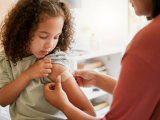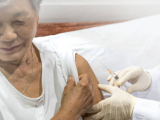May 10, 2011 (CIDRAP News) – US flu vaccine uptake rose nine percentage points from the first snapshot in November, to 42.3%, slightly above last season's 42.1% level, the US Centers for Disease Control and Prevention (CDC) said yesterday.
Public health officials have been eager to see what vaccine uptake levels would be in the first flu season under a new universal flu immunization recommendation, which includes most people ages 6 months and older.
The findings are from the CDC's National Flu Survey, a telephone poll conducted by the National Opinion Research Center at the University of Chicago. The interviews took place between Mar 3 and Mar 30 in 20 local areas and included responses from about 31,000 people.
In November, before the flu season picked up momentum, the same survey showed solid vaccine uptake, with 33% of Americans already vaccinated, 15% saying they definitely planned to get vaccinated, and 25% saying they would probably be immunized.
In the latest survey report, the CDC said flu activity remained low in most parts of the country until the middle of December, when it increased through early February. Last season there was an earlier-than-usual seasonal flu vaccine push to make way for the 2009 H1N1 pandemic vaccine, which arrived later than expected. Demand for the seasonal vaccine was high, due to frequent public health messages about both the seasonal and pandemic vaccines.
This flu season, public health officials hoped that a simpler universal flu vaccination message, along with a record 160 to 165 million doses of flu vaccine, would help boost uptake. In background materials on its Web site, the CDC said 163 million doses were distributed. It's not clear how many were administered.
In the latest uptake report, the CDC said flu vaccination rates were higher for children through age 17, at 46.3%, than for adults, at 41.1% The most recent percentage for children was higher than the percentage who in November were already vaccinated or intended to be vaccinated. However, for adults the same percentage was slightly lower.
Vaccine coverage appeared to vary by region, from a low of 35.1% in Los Angeles adults to 52.7% among adults in Cumberland County, Maine.
The most common places for vaccination for both kids and adults were doctors' offices.
Most adults thought the vaccine was very safe (48.6%) or somewhat safe (33.6%), with most responding that the vaccine was very effective (38.5%) or somewhat effective (32.8%).
The survey did find significant racial or ethnic disparities in flu vaccine coverage, though the CDC said the ability of the survey to detect differences was limited. It said more analyses of uptake differences will be conducted on data from the Behavioral Risk Factor Surveillance System and the National Immunization Survey.
See also:
Dec 3, 2010, CIDRAP News story "CDC sees solid flu vaccine uptake so far"


















